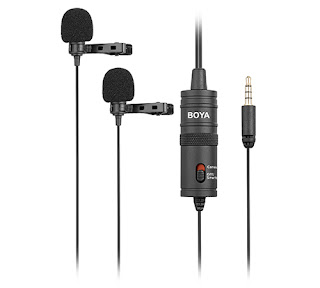I want to buy the Boya BY-M1DM Dual-head clip-on mic, but is it as good as its single-head counterpart, the BOYA BY-M1?
Let's check the specs...
Get it here... https://qoo.tn/BnvnuW/Q100206579
Designed for recording interviews
Here are the Product Highlights...
Transducer: Electret Condenser
Polar pattern: Omni-directional
Frequency Range: 65Hz ~ 18KHz.
Signal/Noise: 74dB SPL.
Sensitivity: -30dB +/-3dB / 0dB=1V/Pa, 1kHz.
Output Impedance: 1000 Ohm or less
Connector: 3.5mm (1/8") 4-pole gold plug.
Battery Type: LR44 (not included) 👈
BOYA BY-M1DM
Dual Omni-directional Lavalier Mic
 |
Designed for recording interviews
Here are the Product Highlights...
- Clip-on lapel microphone for Smartphones, cameras, camcorders, audio recorders, tablets, and other audio/video recording devices
- Omni-directional Condenser Microphone
- 4m (13') length cable, 2.8m(9.2’) between each microphone
- Single 3.5mm (1/8") stereo connector
- Excellent for interviews
- Each Mic Routes to Discrete Channel (🤔 Different audio coming from the left and right.)
- Improved Sensitivity and Signal-to-Noise
- Includes carrying pouch
Here are the technical specifications...
| Transducer: | Electret Condenser |
| Polar pattern: | Omni-directional |
| Frequency Range: | 65Hz ~ 18KHz |
| Signal / Noise: | 74dB SPL |
| Sensitivity: | -30dB +/- 3dB / 0dB=1V/Pa, 1kHz |
| Output Impedance: | 1000 Ohm or less |
| Connector: | 3.5mm (1/8”) 4-pole gold plug |
| Power requirement: | LR44 (included) 👈 |
| Cable length: | 4m(13ft) |
| Net weight: | 68g(2.4 oz) |
And then there is the single Microphone version.
BOYA BY-M1
Omni Directional Lavalier Microphone
Get it here... https://qoo.tn/BBsnuW/Q100206579
Designed for video use
- Applicable to meetings, recording, public communication, outdoor lectures, lectures, and other occasions... podcasting, video and audio editing
- Designed for Smartphones, DSLR, Camcorders, Audio recorders, PC, etc
- Lapel-style microphone
- Omnidirectional condenser microphone
- Decent quality sound with low handling noise
- Small size, lightweight,
- 6 m (20”) long cable.
- 3.5mm (1/8”) 4-pole gold plug
- Includes ¼ inch adapter so it can be plugged into most equipment with the audio input option
- Including the battery, the weight is only 20g.
Here are the technical specifications...
Polar pattern: Omni-directional
Frequency Range: 65Hz ~ 18KHz.
Signal/Noise: 74dB SPL.
Sensitivity: -30dB +/-3dB / 0dB=1V/Pa, 1kHz.
Output Impedance: 1000 Ohm or less
Connector: 3.5mm (1/8") 4-pole gold plug.
Battery Type: LR44 (not included) 👈
The Good: Specs are the same
Both models have the same specs other than the cable length and one more mic.
The Bad: Requires battery
So both require the LR44 battery 🤔... not very exciting anymore... my current Logitech H111 headset and the included Samsung Galaxy headphones don't need batteries. 😡Not knowing when the batteries will run out and carrying spare batteries are very inconvenient and unnecessary extra steps.
Conclusion
It's good if I am using as a professional videographer connecting the mic to a camera or camcorder for a client project.
However, I am now looking for a mic for my own projects using mainly the smartphone, and sometimes (rarely now) the camera or camcorder.
Put the purchase decision on hold... while I go find a batteryless alternative.
Adrian's Journal

Comments
Post a Comment